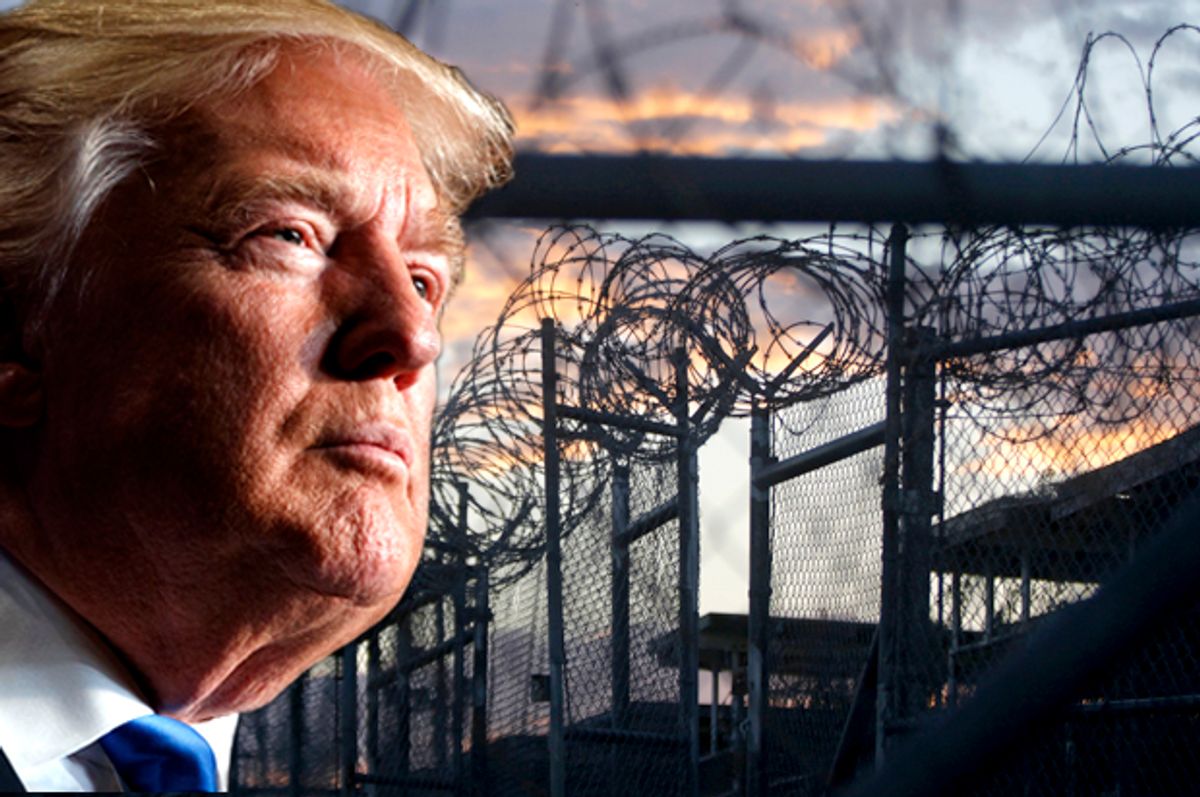While everyone is getting in a lather over Donald Trump’s plans to build his stupid wall and ban Muslims from the country, the new president is busily searching for ways to turn the United States of America back into a torture state. As The New York Times reported this morning, Trump’s administration is working on an executive order that could revive the George W. Bush-era program of detention and interrogation at CIA “black site” prisons overseas. The order also would also set up a review of interrogation policies by senior national security officials. (For what it’s worth, the White House is denying any knowledge of the document.)
This order, if issued, would be the first step toward Trump’s realizing his sadistic campaign promise to reinstate waterboarding and even more brutal torture tactics for no other reason than that suspected terrorists “deserve” to be tortured. Reinstating actual torture, thankfully, is not as easy as all that. As the draft order noted, the National Defense Authorization Act for fiscal year 2016 contained language restricting approved interrogation techniques to those currently outlined in the Army Field Manual. That law “provides a significant statutory barrier to the resumption of the CIA interrogation program,” the draft order noted, somewhat ruefully.
That leaves the administration with a couple of options if it’s serious about bringing torture back, which it seems to be. First, Trump can just break the law and direct the CIA to resume torturing. That’s obviously a dicey proposal, as news of it would almost certainly leak out, and the administration would likely encounter within the national security apparatus some resistance to implementing a clearly illegal torture regime.
Second, the White House can push to have the anti-torture law changed, which also seems like a fraught route. Notwithstanding the ghoulish enthusiasm from some corners of Congress for a renewal of waterboarding, bipartisan opposition would emerge to such a move. Sens. John McCain, R-Ariz., and Rand Paul, R-Ky., are both staunch opponents of torture, and there wouldn’t be nearly enough votes in the Senate to clear a filibuster. There’s also an inherent PR problem involved with an active campaign to legalize torture.
Of course, all this political logic would be tossed out the window if, say, another large-scale terrorist attack strikes the country and the Trump administration leverages fear and panic to ram through whatever nightmarish policies it can dream up in the name of “national security.”
The CIA “black site” prisons represent another lingering and unforgivable stain on the legacy of the George W. Bush administration. As the Senate Intelligence Committee’s report on the CIA detention program makes clear, this was an inhumane and horrifically cruel enterprise managed by incompetent officials. Innocent people were wrongfully detained, interrogations were brutal and slipshod, and one detainee died of hypothermia after being chained half naked to a cement floor overnight. The CIA’s response to all the brutality, incompetence and large-scale violations of international norms was to try and cover it up.
Another thing to remember is that the CIA detention program was such a disaster precisely because the agency is not typically in the business of arresting or incarcerating suspected wrongdoers. John Brennan, until recently the CIA director, said as much in December 2014. The “black site” program “was uncharted territory for the CIA," he explained, "and we were not prepared. We had little experience housing detainees, and precious few of our officers were trained interrogators.” The agency was “unprepared to conduct a detention and interrogation program, and our officers inadequately developed and monitored its initial activities,” he added. Are we just supposed to take it on faith that the CIA will do a better job of it this time around?
One thing we know for certain is that Brennan’s successor, newly confirmed CIA director Mike Pompeo, is a supporter of torture and the CIA “black site” program. “These men and women are not torturers, they are patriots," Pompeo said in 2014. "The programs being used were within the law, within the Constitution.” We also know that Pompeo, like President Trump, is open to changing the National Defense Authorization Act to permit the resumption of waterboarding and other “enhanced interrogation techniques” that currently are illegal.
That we’re even talking halfway seriously about the resurrection of a state-sanctioned torture program is a symptom of a gross institutional failure. And it’s not just the Republicans who are to blame, though they should take the lion’s share of it. Former president Barack Obama absolutely did the right thing when he banned torture and ended the “black site” program, but he also refused to take any action whatsoever against anyone involved in the authorization or implementation of the Bush-era torture regime. Just this week, 14 Senate Democrats voted to confirm Pompeo as CIA director, knowing his record on “enhanced interrogation” and that the president he serves has promised to bring back torture and make it "tougher."
So we find ourselves in a situation where torture is a crime without consequence and “national security” is seen as a legitimate excuse for inexcusable human rights violations. Trump will try to capitalize on that dynamic in his bid to once again make the unimaginable both legal and possible.



Shares